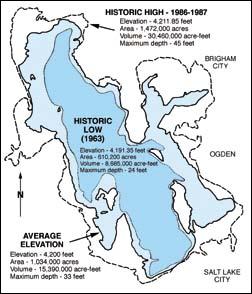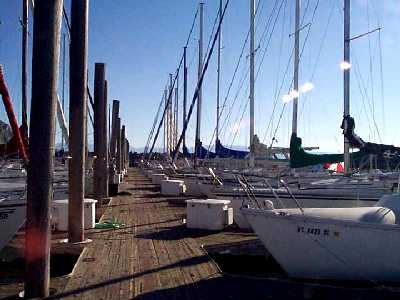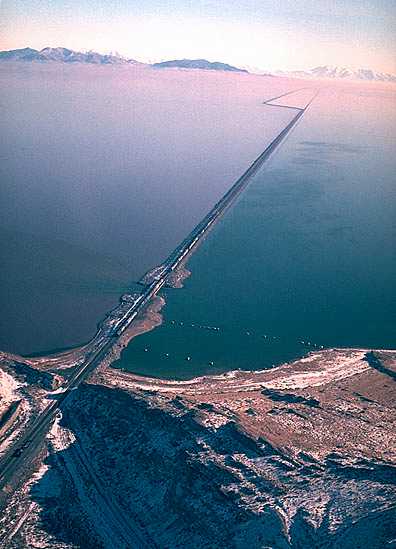GSLYC Great Salt Lake FAQ
Courtesy of Dave Taylor
How deep is the lake?
The level of the lake fluctuates, but at normal levels (4200 ft MSL) the average depth is 15 feet. The maximum depth is about 31 feet. In recent history the lake level has varied from 4191 to 4212 feet MSL. The current lake level is shown on the following link.
http://water.usgs.gov/ut/nwis/uv/?site_no=10010000&PARAmeter_cd=00065,00060,00010,72020
There are few hazards to navigation in the main body of the lake, except there is a relative shallow reef at the harbor mouth. This usually doesn’t present a problem except in shallow water years for deep draft boats. Currently one should sail out using the marked Deep Channel.
It is advisable to get a navigation chart before venturing too far into the lake. These charts are available from the GSLYC
How big is the lake?
The lake’s surface area varies quite drastically as its elevation changes. In 1986, the lake reached a historical high an of 4,212 feet. At that time, the lake expanded to cover about 3,300 square miles. Lake levels hit their historic low in 1963, when the surface stood at 4,191 feet in elevation and covered 950 square miles. As of June 2003, the lake is at about 4,197 feet and covers about 1,200 square miles. |
 |
How salty is the lake?
Salinity varies inversely as the lake level. As the lake rises (more fresh water) the salinity drops. Because the south arm receives all of the fresh water, and since the causeway (see How Big?) prevents adequate circulation, the south arm is less saline (currently about 9%) than the north arm (currently about 25%).
 |
The saturation point of salinity is around 25%, so the north arm is now saturated, and the south arm is getting fresher. This is not good because it will eventually change the entire GSL ecosystem. This imbalance is visible in the causeway photograph where the water north of the causeway is noticeably red due to the bacteria concentration in the super saturated water.
Does the lake really smell that bad?
| Actually the lake doesn’t smell at all. However, the shoreline does. This is because there is a lot of decaying brine shrimp and brine flies that wash up on the shore. |  |
What are brine flies? They sound dangerous. Do they bite?
Brine flies are small flies that usually hatch in late June, and live until the first frost. They do not bite. They are not really as annoying as most people believe. After you have sailed the lake for a while, you learn to ignore them.
Brine flies and the brine shrimp provide food for the myriad of shore birds that live by or visit the lake each year.
What precautions need I take to protect my boat from the salty water?
Normally all that is required for inboard engines is regular zinc replacement to prevent galvanic corrosion. It is wise to flush outboard engines after each use.
As far as topside care, sails and hardware, the normal marine environment precautions are recommended, i.e. rinse off salty sails, and flush hardware with fresh water after use.
Does anything live in the lake, and do I need bottom paint?
|
The only living thing (in any abundance) in the lake are brine shrimp and algae. The shrimp feed on the algae, so both the shrimp and algae populations are cyclical. Most folks use bottom paint to prevent algae growth. Left unchecked, the algae can get quite thick, but can be removed with a good scrubbing. Almost any bottom paint will do. Your choice should be determined by your intended use (racing etc.) |
 |
Are there launch and haul-out facilities?
| We do not have haul out facilities at the lake but we do have many “crane days” scheduled throughout the season. A crane is hired, and the cost is shared among the users. Crane days are major “events” with a lot of participation, and people help one another out. |  |
| For smaller boats (and for those with an adventurous spirit) there is a good launch ramp. After launching or hauling out, the trailer must be thoroughly washed to prevent corrosion. |  |
How are the marina facilities?
|
There are about 300 slips in the Great Salt Lake Marina. The facilities are operated by the Utah State Parks Dept. The marina itself is a state park. There are 4 docks with 25 foot slips (only one of which has shore power. Two dock have 30 foot slips, and one dock has 35 and 40 foot slips. Currently, slip rates are $4.00/foot for a slip without power, and $4.25/foot for slips with shore power. In the winter months (November thru March) the slip rates are half price For more information and for slip availability, you may call the GSL Marina State Park Office at: 801-250-1898. |
 |
You mentioned winter. Is there sailing in the winter months?
|
Yes! Our normal “active” sailing season runs from about April to October, but, because the lake rarely freezes over, there are some truly nice sailing days from November thru March. Most boaters leave their boats in the water year ’round. |
 |
What type of boats use the GSL?
The vast majority of regular users on the lake are sail boaters. There are boats ranging from an Oday 19 to a Frers 43. Catalinas and Hunter are the most popular boats, but there are many other type of sailboats on the lake.
Why don’t power boats use the lake?
There is a perception among the power boaters that putting their boats in the lake will ruin them. Without the proper precautions, it would. Cooling systems can be flushed, though.
Another reason is that there is not much for power boat users to do. There are no fish. The water is extremely salty, so if you were water skiing, it would be wise not to fall.
Is there anywhere to go on the lake?
There are several islands in the south arm of the lake, and lots of people go for overnight (or longer) cruises. In most places the lake shoals up very gradually, so you can’t get too close to shore. There are, however a few places on the islands that you can get within a few hundred feet of the shore.
Antelope Island (the largest in the lake) has a marina on its northern tip. This is a popular destination for weekenders. The GSL Yacht Club also uses this marina for socials and destination races.

